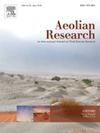不同垫层条件下马铃薯田淡季风致土壤侵蚀
IF 3.4
3区 地球科学
Q2 GEOGRAPHY, PHYSICAL
引用次数: 0
摘要
据估计,全球每年的土壤侵蚀量为750亿吨,农业生产力损失约为4000亿美元,这凸显了有效土壤管理的经济和环境意义。由于大面积的土壤暴露,马铃薯田在淡季特别容易受到风蚀。在阿尔伯塔省南部,秋季床上用品是一种常见的管理做法,包括在秋季而不是春季准备床上用品。秋季垫层为生产者提供了物流和经济优势,但由于土壤扰动增加,它可能增加淡季风蚀的风险。为了研究这一点,在莱斯布里奇理工学院灌溉示范农场,使用改良威尔逊和库克(MWAC)采样器测量了风蚀,并使用风蚀预测系统(WEPS)模型模拟了三个非季节(2021-2024)的风蚀。在三种层理下评估了风蚀率:春季层理、冬季覆盖作物后的春季层理和秋季层理。测量和模拟的速率表明,在所有三个淡季期间,秋季垫层经历了最大的风蚀速率。平均而言,秋季层理下的淡季风蚀是春季层理下的20倍。研究发现,WEPS模型与实测数据吻合较好,模型精度较高(R2 = 0.9327, Nash-Sutcliffe效率(NSE) = 0.9058)。统计分析显示,不同层理类型的侵蚀速率存在显著差异(P < 0.05),而落层理始终导致更高的侵蚀。在春季垫层之前种植冬季覆盖作物的好处不太明显,这表明与单独种植春季垫层相比,在谷物作物之后种植冬季覆盖作物可能提供最小的额外侵蚀减少。这些发现提倡采用春季垫层来减少淡季风蚀及其相关的经济和环境成本。结果还强调了在马铃薯种植中选择床上措施时考虑经济和长期可持续性的重要性。本文章由计算机程序翻译,如有差异,请以英文原文为准。
Off-season wind-induced soil erosion from potato fields under varying bedding preparations
Annually, global soil erosion is estimated at 75 billion tonnes, costing approximately US$400 billion in lost agricultural productivity, highlighting the economic and environmental significance of effective soil management. Potato fields are particularly susceptible to wind erosion during the off-season, due to extensive soil exposure. In Southern Alberta, fall bedding is a common management practice, involving bedding preparation in the fall rather than spring. Fall bedding presents logistical and economic advantages to producers, but it may increase the risk of off-season wind erosion due to increased soil disturbance. To investigate this, wind erosion was measured using Modified Wilson and Cook (MWAC) samplers and modelled with the Wind Erosion Prediction System (WEPS) model across three off-seasons (2021–2024) at the Lethbridge Polytechnic Irrigation Demo Farm. Rates of wind-induced soil erosion were evaluated under three bedding types: spring bedding, spring bedding following a winter cover crop, and fall bedding. The measured and modelled rates indicate that fall bedding experienced the greatest rates of wind-induced erosion across all three off-season periods. On average, off-season wind-induced erosion under fall bedding was 20 times higher than that under both spring beddings. The study found that the WEPS model closely aligns with measured data, showing high model accuracy (R2 = 0.9327, Nash–Sutcliffe efficiency (NSE) = 0.9058). Statistical analyses revealed significant differences in erosion rates across bedding types (P < 0.05), with fall bedding consistently leading to higher erosion. The benefits of winter cover crops prior to spring bedding were less pronounced, suggesting that winter cover cropping may offer minimal additional erosion reduction compared to spring bedding alone when following a cereal crop. These findings advocate for the adoption of spring bedding to reduce off-season wind erosion and its associated economic and environmental costs. The results also underscore the importance of considering both economic and long-term sustainability when selecting bedding practices in potato cultivation.
求助全文
通过发布文献求助,成功后即可免费获取论文全文。
去求助
来源期刊

Aeolian Research
GEOGRAPHY, PHYSICAL-
CiteScore
7.10
自引率
6.10%
发文量
43
审稿时长
>12 weeks
期刊介绍:
The scope of Aeolian Research includes the following topics:
• Fundamental Aeolian processes, including sand and dust entrainment, transport and deposition of sediment
• Modeling and field studies of Aeolian processes
• Instrumentation/measurement in the field and lab
• Practical applications including environmental impacts and erosion control
• Aeolian landforms, geomorphology and paleoenvironments
• Dust-atmosphere/cloud interactions.
 求助内容:
求助内容: 应助结果提醒方式:
应助结果提醒方式:


